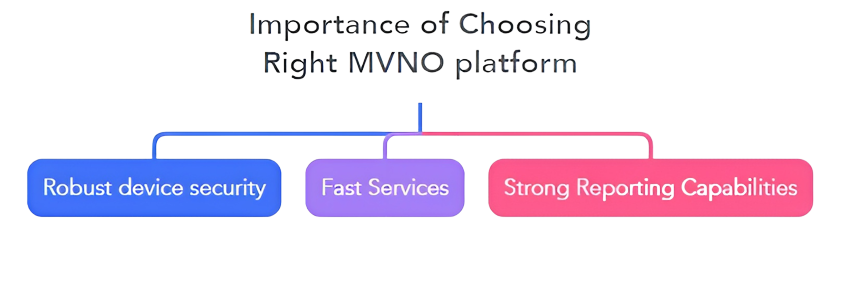What is Mobile Virtual Network Operator (MVNO)?
- July 13, 2023
- Registrationwala
- Home
- /
- Knowledge Base
- /
- Other Registrations & Licenses
- /
- VNO License
- /
- What is Mobile Virtual Network Operator (MVNO)?
What is Mobile Virtual Network Operator (MVNO)?
The MVNO full form is Mobile Virtual Network Operator. These are the companies that provide wireless communication services. Here the company does not own a mobile spectrum license but sells mobile services under its brand name using the network of a VNO licensed mobile operator.
This term is given to different MNOs. On one hand, they offer mobile services under a particular brand. With their own marketing and tariff structure, usually they did this through a sophisticated CRM system.
On the other hand, these companies have their own core network infrastructures. Also they issue their own SIM cards and control elements of network infrastructure. Below we explain how the MVNO business models look and what make them unique.
What is Unique in MVNO?
The MVNO has three types based on the models they use but they share the similar set of characteristics that make them unique. The specialities of MVNOs are as follows:
- They already have access to a large base of customers.
- Having loyal customers makes the process of selling products and services easier.
- Access to capital that helps them to invest in front-end systems to cater to consumers.
Mobile Virtual Network Operator Types
An MVNO type is majorly classified into three categories:
.png)
Branded Reseller
The MVNOs use the services of current service providers such as MNOs and MVNEs and then resell the predetermined services under their name.
The branded resellers are the lightest and quickest model of MVNO to create because they use premade settings. That’s why they have more free time to concentrate on other things such as marketing, sales, and relationship building.
Also they invest less amount as compared to other MVNOs. Low investment means, they have less impact on the created products which they offer to a market, also the revenue they generate.
Light MVNO
The light MVNOs lie between the Branded Reseller and Full-MVNOs. They operate the following operations: sales and marketing, back-office processes, value added services.
As compared to Branded Reseller, Light MVNOs are more adaptable, and maintain the ownership of other things as well. Applications and service management, rating and billing, customer service, sales and marketing all of these are included in light MVNO.
Full-MVNO
The full MVNOs have full infrastructure. They have the greatest flexibility and operator infrastructure as compared to other MVNOs. It manages several key network components but only hosts networks that are in radio access.
Basically, the Full MVNOs manage and set up their own SIM cards, call flows, SMS flows, and data flows to manage their basic network and infrastructure.
What Does a Mobile Virtual Network Operator Do?
An MVNO doesn’t have any mobile network infrastructure but they provide all the network services that help their clients. The other services that MVNO provide are as follows:
- Manage the bills and invoices of clients
- Promote products
- Subscribe to the network
- Offer subscribers services like balance checks, network top-ups, customer care and SMS capabilities.
- Distribute SIM cards and mobile phones
Need a Mobile Virtual Network Operator?
There are two reasons for that, the mobile operators choose to leverage MVNOs. The reasons are as follows:
An opportunity to reach non-targeted segments
Mobile operators are like most brands; they are always looking to grow, but growth can sometimes be hard to achieve. A solution is to find partners with large customer bases. These partners are able to position themselves and leverage brand affinity to sell more mobile network services to their customers.
Leverage infrastructure to create additional revenue streams
Mobile network infrastructure is also often capable of managing more user requests than it has at any given time. And for mobile operators, this presents the opportunity to offer unused bandwidth to MVNOs, making it possible to sell access to infrastructure and generate revenue.
Things to Consider While Choosing a Right MVNO Platform
To deliver the best services, the MVNOs are required to have a secure, flexible, and robust loT platform, with a VNO license. Here are the other important features that the MVNO should consider while selecting platform:

Robust Device Security
IoT is a vulnerable technology. The mobile devices are not normally updated with the latest technology, which makes it easily susceptible to malware and other malicious threats.
When a network is introduced to these devices, then it increases the chances to multiply the threats in other devices. So, to avoid the security threats, an MVNO should invest in a platform which offers the flexible mechanism for FOTA and SOTA to make their customers devices free from malware.
Fast Services
An MVNO understands the graphical user interface, device auto discovery, no-code environment. So, these are the features that streamline the service deployment for MVNO, it makes it easier to serve the existing and new customers.
Strong Reporting Capabilities
It is always better to cure the issue before it increases. So, an MVNO can prevent device critical failure by reaching out to the information of customers and their devices. And the platform will understand and manage the irregularity.
Conclusion
An MVNO is a wireless communications service provider that can bring more value to the market. They do this by providing mobile network access to more customers, and giving more competitive products and services.
Some MVNO platforms that are growth oriented can invest in the right IoT platform that improves the operational efficiency and eventually make it possible to scale with ease.
- 4339 views